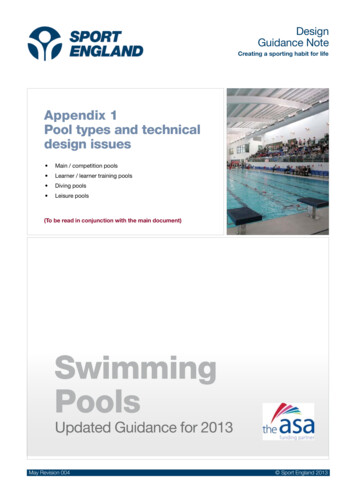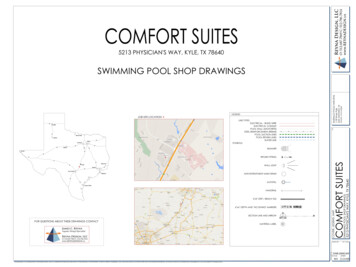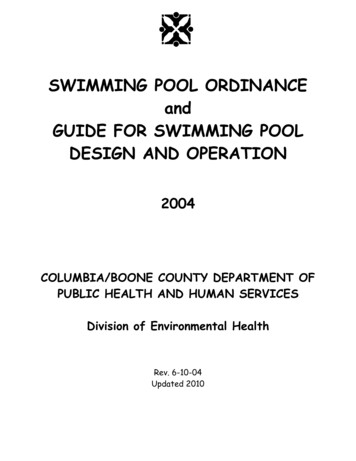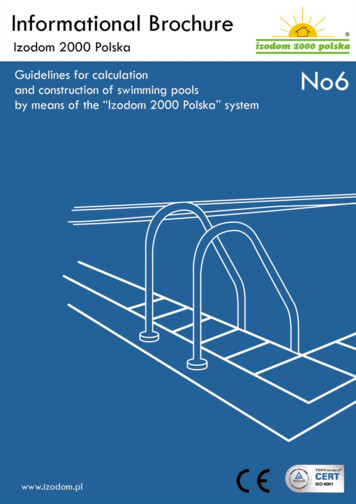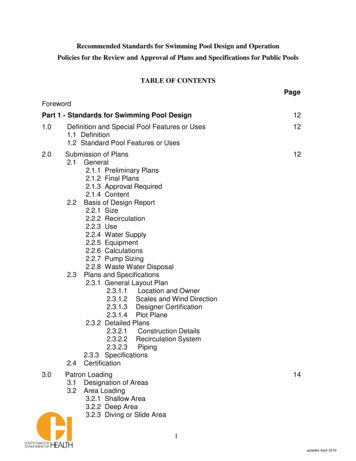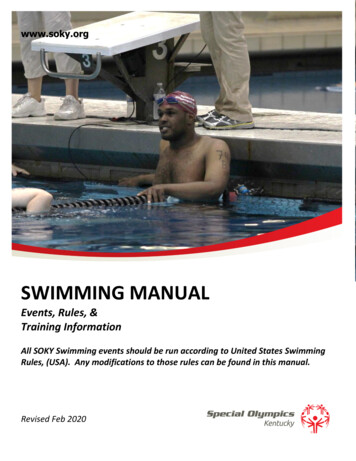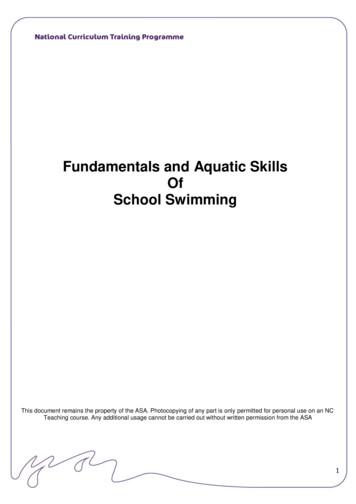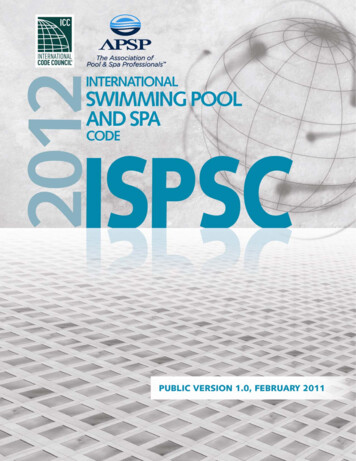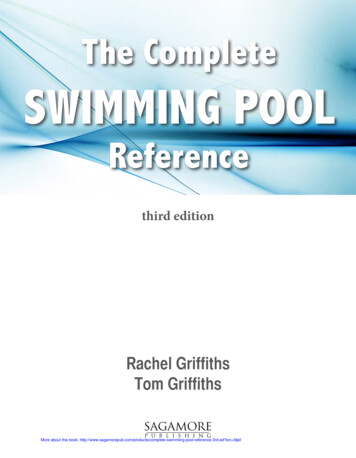
Transcription
The CompleteSWIMMING POOLReferencethird editionRachel GriffithsTom GriffithsMore about this book: ing-pool-reference-3rd-ed?src fdpil
2014 Sagamore Publishing LLCAll rights reserved.Publishers: Joseph J. Bannon and Peter L. BannonDirector of Sales and Marketing: William A. AndersonSales Manager: Misty GillesJournals Marketing Manager: Emily WakefieldDirector of Development and Production: Susan M. DavisTechnology Manager: Keith HardymanProduction Coordinator: Amy S. DagitGraphic Designer: Julie SchechterCover Photo Courtesy of Councilman-HunsakerISBN print edition: 978-1-57167-763-1ISBN ebook: 978-1-57167-764-8LCCN: 2014941711Sagamore Publishing1807 N. Federal Dr.Urbana, IL 61801www.sagamorepub.comMore about this book: ing-pool-reference-3rd-ed?src fdpil
To Coach Bill Campbell (8/9/1923–4/24/2014), whose personal and professional mentoring catapulted meinto my career as an aquatics professional at the University of Maryland many, many years ago.To my daughter Rachel, who by far completed most of the research and writing of this third edition. Herhard work, dedication, and attention to detail are beautifully illustrated in the text.As she continues to motivate me and energize my efforts, may this book serve as her springboard into along and rewarding career in aquatics.— Dr. Tom GriffithsTo my grandmother, Esther Reines (1/28/1926–3/25/2014), who continually reminded us how our valuablework ethic would lead to success and repeatedly praised us for it.More about this book: ing-pool-reference-3rd-ed?src fdpil— Rachel Griffiths
CONTENTSPreface. viiIntroduction. ixSection I: Pools1A Water Safety Primer.32A Pool Primer: Basic Characteristics of Pools.73Residential Pools.154Traditional Public Pools.315Aquatic Facility Planning and Funding by Kevin Post.596Americans with Disabilities Act (ADA) by John Caden.69Section II: Mechanical7Circulation.838Filtration.1019Improving Air Quality in Indoor Pools .113Richard C. Scott, Erik Knight, Ryan Smedema, ContributorsSection III: Water Chemistry10Disinfection and Supplemental Sanitizers.12111Ultraviolet Light (UV) Disinfection.127Tom Schaefer, Engineered Treatment Systems LLC, Emperor Aquatics, Contributors12Chlorination and Bromination.13313Superchlorination.14114Pool Calculations.14715pH, Water Balance, and Chemical Adjustments.15316Water Testing .173vMore about this book: ing-pool-reference-3rd-ed?src fdpil
17Pool Problems.18518Recreational Water Illnesses (RWIs).195Michael Beach, ContributorSection IV: Specialty Pools19Hot Tubs and Spas.21120Waterparks.225P. J. Heath, World Waterpark Association, Contributors21Winterizing.249Section V: Safety, Supervision, and Risk Management22The Psychology of Lifeguarding.263Chapter Introduction by Daniel Simons23Preventive Lifeguarding.27724Shallow Water Blackout.29525Rethinking Pool Signage.30126Diving and Other Headfirst Entries.30927Virginia Graeme Baker Pool and Spa Safety Act and Body, Hair, and Limb Entrapments.32528Practical Risk Management .32929Insurance and Aquatic Risk Management by Gareth Hedges.33330Legal Liability and Risk Management by Shawn P. DeRosa.34331Preparing for and Coping with Emergencies by Shawn P. DeRosa.35732Routine Operations: Daily, Weekly, Monthly.36333Safe Handling of Pool Chemicals by Kerry Hoffman Richards.369Appendices.385Glossary.435About the Authors.444Index . .447viMore about this book: ing-pool-reference-3rd-ed?src fdpil
PREFACEThe Complete Swimming Pool Reference, Third Edition combines technical aspects of pool operations manualswith practical information often found in water safety texts. The book is written for all those who own, operate, orotherwise work at swimming pools, including lifeguards, pool operators, pool managers, swimming coaches, divingcoaches, swimming instructors, and even residential pool owners.This book is written clearly and concisely so that even complicated topics are easy to understand. With 33 comprehensive chapters included, there is something for every aquatic professional. New chapters in the third editioninclude Chapter 1, A Water Safety Primer, Chapter 5, Aquatic Facility Planning and Funding, Chapter 6, AmericansWith Disabilities Act, Chapter 9, Improving Air Quality in Indoor Pools, Chapter 11, Ultraviolet (UV) Disinfection,Chapter 24, Shallow Water Blackout, Chapter 27, The Virginia Graeme Baker Pool and Spa Safety Act, Chapter 29,Insurance and Aquatic Risk Management, and Chapter 31, Preparing for and Coping With Emergencies.Reviewing the latest information found in these newly added chapters should certainly place readers on the cutting edge of aquatic facility management and is of vital importance to today’s aquatic professionals. This work alsoincludes a variety of references and resources to assist readers who wish to study a topic in greater depth.viiMore about this book: ing-pool-reference-3rd-ed?src fdpil
INTRODUCTIONSwimming attracts more than 125 million participants annually; this figure represents nearly half of the U.S.population. For years, swimming has been the most popular participant sport in the United States. Only walking hassurpassed its popularity in recent years.According to the CDC, swimming is the most popular recreational activity for children and teens. The Association of Pool & Spa Professionals estimate there are nearly 10 million pools in this country. Six million are privatelyowned, residential pools. Homeowners maintain an additional three million hot tubs and spas. The number of publicand semi-public pools in this country is approaching one million.People frequent pools for a variety of reasons: fitness, relaxation, instruction, competition, and therapy. Today’sswimming facilities do not just accommodate lessons and lap swimmers but are multidimensional fitness and familycenters serving all age groups. Many recreational amenities have been added to pools like climbing walls and slides.During the writing of the first edition of this book in the early 1990s, the drowning rate remained fairly constant,between 7,000 to 8,000 individuals a year. Fortunately, death by drowning was actually reduced to around 5,000 annually during the writing of the second edition of this book. During the writing of this third edition, the drowningrate is now below 4,000. Even though more and more Americans are being exposed to a growing number of aquaticfacilities and activities, the fact that the drowning rate is actually decreasing bodes well for our water safety programs.Fortunately, only 10% of these drownings occur in swimming pools, but tragically almost half of these drowningsinvolve small children. Some claim that nearly 500 drownings occur each year in guarded facilities.Ironically, we build pools in this country to promote health, fitness, and safety, but several risks and hazards areproduced with the construction of swimming facilities. This book can help maximize the health and safety benefits ofaquatics while reducing hazards and risks. This third edition contains new and improved information on safe aquaticfacilities and activities. Aquatic Facility Planning and Funding, ADA, Entrapments, Air Quality/UV, Insurance andLegal Liability, and Shallow Water Blackout are some of the exciting new chapters. Safe, enjoyable, and clean swimming pools should result if the guidelines in this book are followed.There are many good texts available that can assist the swimming pool owner, operator, or other employees.Some texts are technical and written primarily for swimming pool technicians who need precise information onpool chemistry and filtration. Concerning safety, the American Red Cross along with the YMCA, Ellis & Associates,NASCO, and the StarGuard program are the leaders on lifeguarding and water safety and produce excellent workson these subjects. Residential pool owners are often referred to pamphlets published by swimming pool chemicalcompanies that are easy to follow and understand.The Complete Swimming Pool Reference, Third Edition, attempts to accomplish the formidable task of combiningthe most valuable elements of technical, practical, and water safety publications to produce a book that can be usedby anyone in aquatics.It is hoped that anyone associated with a pool, whether it be public or private, will find this book informativeand helpful. The needs of homeowners, hotel/motel managers, park directors, pool operators, lifeguards, coaches,and parents are addressed. This book includes many other references and resources that will allow the reader to gainadditional information concerning pools and spas. All readers will benefit from this book, from professional pooltechnicians who service swimming facilities to homeowners who relax in their hot tubs.How to Use this BookThe information presented in this book progresses from very simple ideas to more complex swimming poolissues. The novice pool owner or operator may wish to concentrate on the earlier sections before moving on to thefiltration and chemistry chapters. Conversely, the experienced pool person may wish to skim the initial chaptersixMore about this book: ing-pool-reference-3rd-ed?src fdpil
and spend more time on the later sections in the book. Additionally, some readers will prefer to concentrate on themaintenance and operations sections of the book, while others may want to focus on the safety and human relationsportions.Before addressing each chapter, the reader should carefully read the key terms defined at the outset of each section. Reviewing the key terms will aid the reader in attending to the most critical aspects of each chapter. AppendixB contains a “Personal Pool Profile” that can be completed so the information read can be applied directly to thereader’s particular pool.In addition to this book, there are several other valuable sources of swimming pool and water safety information. The American Red Cross, American Swimming Pool and Spa Association, The Association of Aquatic Professionals, The Centers for Disease Control, Ellis & Associates, StarGuard, The National Aquatic Safety Company, TheU.S. Consumer Product Safety Commission, The Association of Pool & Spa Professionals, National Swimming PoolFoundation, The Y, and the National Recreation and Park Association are just a few organizations that can providethe reader with additional information on swimming pools and spas. Websites can be found in Appendix A.Every pool owner and operator must understand fully the local health codes and ordinances that regulate swimming facilities in their region. This book is not intended to replace or supersede local swimming pool regulations;The Complete Swimming Pool Reference, Third Edition only serves as a general guide and helpful reference for thosewho own or operate swimming pools and spas. The reader must also understand that many state health codes regulating swimming pools are out of date. Much of what is found in these pages is more up to date. Readers must alsohave a good understanding of the Model Aquatic Health Code (MAHC) and the Americans with Disabilities Act(ADA).xMore about this book: ing-pool-reference-3rd-ed?src fdpil
Section IPoolsWe introduce the third edition of the Complete Swimming Pool Reference with our latest thoughts and discoverieson water safety. We wanted to lead off with this section because most swimming pool books do not discuss this vitally important topic sufficiently. The use of life jackets in swimming pools—yes, that’s right, in swimming pools—aswell as the latest advances in drowning detection technologies are discussed here.Chapter 2 contains a brief, general description of swimming pools, including a classification of different types ofpools to provide a basic overview that should be particularly helpful for novices. Topics introduced include circulation, pool configurations, construction materials, finishes, decking, and equipment. Safety, signage, and supervisionare also introduced in this section, and chemical balancing is mentioned briefly. These topics are discussed in greaterdetail later in the book.Chapter 3 specifically addresses the residential pool. This chapter is a comprehensive treatment of private pools,and the emphasis in this chapter is on safety. Layers of protection and pool barriers are important aspects of thischapter. This chapter is primarily written for homeowners who either have pools or are considering the constructionof a pool on their premises. Additionally, residential pool service technicians might find this chapter helpful. Topicssuch as filtration, circulation, and water chemistry will be presented in Sections II and III.Chapter 4 discusses public pools in detail. Different types of pools are discussed, as well as construction materials and pool equipment. Ladders, lights, finishes, markers, barriers, programming, and security are covered in thissection. Special considerations for outdoor pools are also discussed. Pool areas such as the entrance, locker rooms,first aid room, staff room, and concession areas are also included in this chapter. Chapters 1, 2, and 3 cover swimming pools in general terms.We wind down this section with two new chapters. Chapter 5 deals with long-range planning and funding fornew aquatic facilities, illustrating a rational and detailed approach. Chapter 6 discusses the latest updates with theAmericans with Disabilities Act (ADA). This chapter illustrates the many and varied ways of improving the accessibility of your swimming facilities.More about this book: ing-pool-reference-3rd-ed?src fdpil
More about this book: ing-pool-reference-3rd-ed?src fdpil
1A Water Safety PrimerAs noted in the second edition of The CompleteSwimming Pool Reference (2003), whenever a hazard iscreated at the pool, it should be repaired or removed immediately. Accidents at the pool are usually the resultof a combination of irresponsible actions on the part ofthe pool patron, inadequate supervision, and a failure towarn. In this third edition, we provide new approachesto water safety. In this chapter, we focus on strengthening supervision and supplementing supervision.the towel on supervising, training lifeguards, or improving vigilance. Vigilant supervision is still key. However,the lifeguard toolbox of safety measures must expand toinclude ALL of the most effective nuts, bolts, and screwsfor water safety. The water safety culture should shiftfrom solely supervision to strengthening supervision ANDsupplementing supervision.SupervisionStrengthening supervision is detailed in Chapter23 and Chapter 24. New cutting-edge research unveilsthe prevalence of internal noise and other distractionsfor lifeguards, in addition to the challenges of physicalbody blindness and cognitive body blindness. This research has led to new strategies to strengthen supervision through methods to help manage internal noise, aswell as mix up scanning techniques so scanning does notbecome too routine and too habitual, which can lead tomissing victims in the water. The Complex Quadriplexof Lifeguard Blindness (CQLB)—the four most significant challenges lifeguards face, along with “the habitof scanning”—illustrates how critical it is to strengthensupervision. However, the CQLB also demonstrates thatno matter how strong supervision becomes, it will always have limitations. Thus, supplementing supervisionis dire as well.These topics may be mentioned in more depth laterin the book. However, this is critically important information for safety in aquatic environments and thus vitalto emphasize up front. Safety at the pool is a win for everyone.Much has changed since the publication of The Complete Swimming Pool Reference in 1994 and 2003. For decades, we preached that parental (adult) supervision andvigilant lifeguarding were the cornerstones of drowningprevention programs and the most important Layer ofProtection. Although we still believe that close, active,continuous supervision of children by adults and lifeguards is essential, we now believe that in many cases, ifnot most, technology is more effective than human supervision in regard to drowning prevention. Althoughthis may sound like heresy in some water safety circles,human error is the number one cause of accidents worldwide, and the best of supervision can be spotty. Humanbeings are unable to remain vigilant for extended periodsof time, and distractions are a part of everyday life, particularly in our world of handheld communications andtechnology. We have spent years researching the role ofboth technology and supervision in monitoring humansand have made a recent epiphany: Parents and lifeguardswill continue to fail to protect lives in the water if theycontinue to rely solely on the human senses to preventdrowning. This is not to assert that we should throw inStrengthening SupervisionSupplementing Supervision:Water Safety TechnologyFortunately, many of the technologies we recommend are inexpensive and effective. A major motivationfor writing this third edition of The Complete Swimming Pool Reference is to change the water safety focusof “solely supervision” to a culture of supervision combined with better pool design and safer technologies fordrowning detection and prevention.More about this book: ing-pool-reference-3rd-ed?src fdpil
4The Complete Swimming Pool ReferenceLife JacketsRepeatedly throughout this book, we will encourage readers to promote the use of life jackets in swimming pools, rather than reserving life jackets for openwater use only. We believe that if all nonswimmerswould buckle up in life jackets before going into the poolwith the same consistency they buckle up in seat beltswhen they enter automobiles, the drowning rate woulddrastically decline. Identifying nonswimmers and thenfloating them in appropriately fitting U.S. Coast Guardapproved life jackets is the cheapest and most effectivelife insurance policy we can offer those recreating in, on,and around ALL bodies of water. Keep in mind, we stillencourage close, active, vigilant supervision by adultswhenever nonswimmers are around the water, evenwhen they are wearing life jackets.Figure 1.1. Proper fitting of life jackets for youngchildren is important.Note & Float Note & Float is a national program designed to reduce the risk of disability and drowning at aquatic facilities. Everyone should buckle up in a life jacket in, on, andaround open water, and many state laws require the useof life jackets in watercrafts. Life jackets for nonswim-mers are a must in open water and in swimming pools.Figure 1.1 shows a young nonswimmer excited as shegets buckled in a Note & Float life jacket for swim lessons. Life jackets are the cheapest, most effective formof life insurance that can be bought. As new water safetystrategies and technologies are developed to keep poolssafer, the use of lifesaving tools that already exist is a nobrainer. Life jackets are not new, yet they are not commonplace for pools. Life jackets save lives, so they shouldbe used to save lives at pools as well.Swimming pool parties are extremely popularthroughout the world. Birthday pool parties are especially entertaining. Unfortunately, pool parties are notall fun and games. In fact, more than half of all drownings in guarded swimming pools occur during pool parties. For several reasons, parents, lifeguards, and othersupervisors become distracted during pool parties. Thisis why drowning often occurs at these times. On-dutylifeguards alone cannot prevent pool drowning becausein a pool party setting, lifeguards often do not know allthe children and do not know who can swim and whocannot. A strong group use policy is needed for pool parties along with the Note & Float program.Note & Float is a program that identifies swimmersand nonswimmers and floats nonswimmers in life jackets. The Note & Float program instructs patrons (especially children) to wear wristbands that designate swimmers and nonswimmers. Nonswimmers are required towear a U.S. Coast Guard-approved life jacket, stay withinarm’s reach of a parent, and stay in shallow water 5 ft andunder. See Figure 1.2 for simple safety steps to implement a Note & Float program. All nonswimmers shouldalways wear a life jacket at residential pools, at publicpools, and in, on, and around open water. Swim lessonsare still imperative early and often. In fact, buckling nonswimmers into life jackets helps acclimate children whootherwise would not be able to swim to the water andoften is an impetus for swim lesson enrollment. All children should learn to swim, but before they can, float ’em.Child Pool AlarmsTechnology can monitor humans better than humans can monitor humans. The original Safety Turtle is an extra layer of protection for children, which is primarily intended for children who are not supposed to bein the pool. The Safety Turtle is a colorful turtle-shapedwristband (like a watch), with an alarm, which instantlydetects immersion in water and sends a radio signal tothe base station (See Figure 1.3.a). The Safety Turtle istypically used in residential pools, and the base station,often located in the house, alerts the household with aloud, distinctive alarm. The base station also has a rechargeable battery and can be portable for use at a nonresidential pool. The Safety Turtle was designed specifi-More about this book: ing-pool-reference-3rd-ed?src fdpil
A Water Safety PrimerThe NationalNote & FloatTMWater Safety ProgramBecause we care Six simple steps to safety!ALL non-swimmers must be registered at the facility bya parent/guardian prior to or upon entry to the facility.Parents/guardians and non-swimming children should ! instructions along with “Learn to Swim” information.Parents/guardians will be advised to SUPERVISE theirchildren and keep them within arm’s reach.Non-swimmers seven years of age and under (or less ! wrist band and a United States Coast Guard ApprovedLifejacket Type III, and remain in designated shallowwater areas. They must also be within arm’s reach of aparent/guardian (at least 16 years of age) who is in thewater with the child.Non-swimmers ages eight through twelve must wear ! wrist band and a USCG-ApprovedLifejacket Type III, and must be actively supervised by aswimming parent/guardian (at least 16 years of age).Anyone who wishes to access deep water (greater than! USCG-Approved Lifejacket Type III.5cally for young children, locks in place, and can help savelives. This should be used as an extra layer of protection,supplementing (not replacing) supervision, in conjunction with self-closing, self-latching gates, among othernecessary layers of protection. We will discuss the SafetyTurtle for improved emergency response in guardedpools in Chapter 4.The SEAL swim monitoring and drowning detectionsystem is promising new technology that detects a swimmer in distress and alerts lifeguards and parents in timeto rescue the swimmer (Figure 1.3.b). The SEAL consistsof a central hub that connects with SEALBands that areworn around the neck by swimmers and GUARDBandsthat are optionally worn by parents, caregivers, and lifeguards. The SEAL triggers visible, audible, and vibratingwarnings and alarms on all devices (hub, SEALBand,GuardBands) notifying parents, lifeguards, and otherswimmers to initiate a rescue.PoseidonFor larger municipal pools, Poseidon computeraided drowning detection systems may be used (see Figure 1.4). As of writing this edition, Poseidon technologysystems have detected 22 drowning victims in guardedfacilities, resulting in successful rescues. In all cases,the lifeguards initially missed the victims. However, after they were alarmed by the Poseidon system, the lifeguards responded and rescued the individuals. We willdiscuss the paramount need for water safety technologyin-depth in Chapter 23.Additional Layers of Protection ! www.aquaticsafetygroup.comDesigned to reduce drowning at aquatic facilitiesFor program replacement items Call WSP 1-800-987-7238 ext. 4Figure 1.2. Six easy steps for Note & Floaton a handy rack card.Swim LessonsSomewhat surprisingly, our philosophy on swimming lessons has also shifted. After years of suggestingthe best years to enroll children in swimming lessonsFigure 1.3.a. The Safety Turtle wristband sounds an alarm when immersed in water and is an excellentextra layer of protection, especially for residential and unguarded pools. (Photos courtesy of Safety Turtle )More about this book: ing-pool-reference-3rd-ed?src fdpil
6The Complete Swimming Pool Referencesafety signage systems that focuses on four vitally important safety warnings that can result in catastrophic injury and death if not obeyed in public and private pools.Signage should use warning shapes, symbols, and colors,with the most important rules disp
The Complete Swimming Pool Reference, Third Edition only serves as a general guide and helpful reference for those who own or operate swimming pools and spas. The reader must also understand that many state health codes regu-lating swimming pools are out of date.
